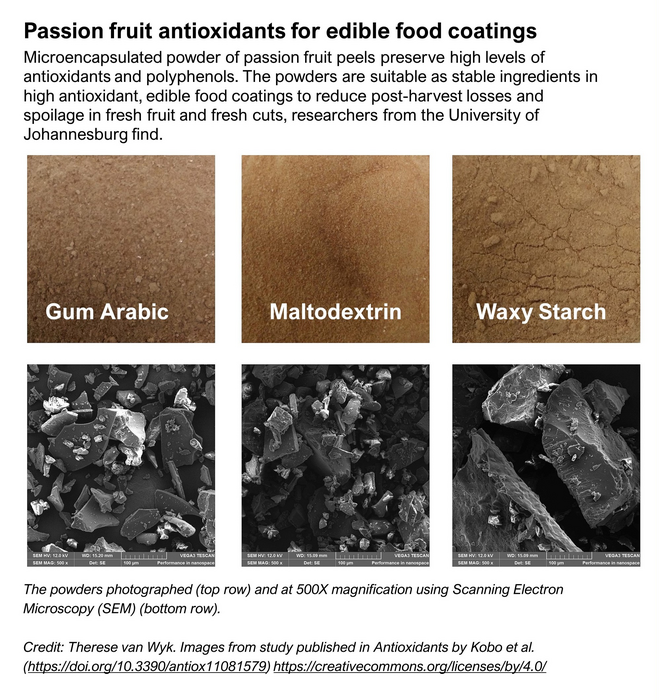The high antioxidants and polyphenols content in passion fruit peels show significant potential to preserve fresh fruits and fresh cuts in an edible food coating, shows research from the University of Johannesburg. Such a coating can reduce spoilage and plastic packaging in supply chains.

Credit: Credit: Therese van Wyk. Images from study published in Antioxidants by Kobo et al.
(https://doi.org/10.3390/antiox11081579) https://creativecommons.org/licenses/by/4.0/
The high antioxidants and polyphenols content in passion fruit peels show significant potential to preserve fresh fruits and fresh cuts in an edible food coating, shows research from the University of Johannesburg. Such a coating can reduce spoilage and plastic packaging in supply chains.
The researchers extracted, micro-encapsulated, freeze-dried and powdered passion fruit (Passiflora edulis Sims) peels from an organic farm. This varietal is known for its medicinal value. Globally, passion fruit is mainly grown for concentrated juice.
Their metabolomic and other analyses in Antioxidants show the powders have the properties needed for a quality, stable, edible food coating. The powders can also be functional ingredients in natural food additives.
When fresh produce is packaged in plastic, the plastic creates a ‘micro-atmosphere’, says Prof Olaniyi Fawole, from the University of Johannesburg. And that puts the brakes on what oxygen can do to the produce.
“Oxygen is the bad guy, it causes a lot of biochemical degradation. So we want to limit the oxygen that gets to the produce. And we also want to limit dehydration. Edible food coatings can potentially solve both the oxygen and dehydration problems in the cold chain,” he adds.
The ideal coating
“If you coat the product, you reduce the interference from a high oxygen atmosphere, because there is a barrier. Dehydration is prevented because the coating keeps the moisture on the inside,” says Fawole.
However, any such coating needs to have high antioxidant content to help prevent spoilage due to oxidation and should also contain antimicrobials. An edible coating should not interfere with the colour, appearance or taste of the product.
Fresh cuts of fresh fruits, which spoil even faster than whole fruit, and which are exposed to far more microbes and dehydration, can benefit even more from such a coating.
Microencapsulation to preserve antioxidants and polyphenols
The microencapsulation process preserved high antioxidant and polyphenol content from the passion fruit peels. This is significant, because antioxidants and other bioactive compounds are easily destroyed by industrial processes, pH, high storage temperature, oxygen, light, solvents, and metal ions.
The researchers used one of three carriers for the microencapsulation: gum arabic (GA), maltodextrin (MT), or waxy starch (WS). When they measured the encapsulation efficiency (EE) of the three carriers, they found EE’s from 82.64 to 87.18%. This indicates that antioxidants and polyphenols should be well preserved within the microcapsules of the coated powder particles.
Then they analysed each encapsulated powder in turn for antioxidants and polyphenol content.
Bioactive analysis results
Phytochemicals such as polyphenols are numerous in plants, and no single analysis can describe the antioxidant content of the powders. Instead, the researchers used two analyses to indicate to what extent the encapsulation process affected the antioxidant activity of the bioactive compounds contained in the microparticles.
The first, DPPH radical scavenging activity showed that all three carriers possessed 45.85 to 51.29 mM Trolox Equivalent (TE)/ g DM (WS).
The second, ferric reducing antioxidant power (FRAP), showed that the carriers possessed 32.30 – 37.47-mM TE/ g DM.
Trolox is a synthetic water-soluble antioxidant, and it has been used as a standard antioxidant for these antioxidant assays.
There is a drive towards alternatives to synthetic antioxidants as their safety could be questioned by consumers.
“The results mean that the encapsulated powders could be viable alternatives to synthetic antioxidants and can provide valuable properties such as antibrowning and anti-senescence behaviour. They also offer the additional benefit of being edible,” says Fawole.
To identify which polyphenols are present in the microencapsulated powders, the researchers ran metabolomic analyses, using liquid chromatography mass spectrometry (LC-MS).
Commercially important polyphenols preserved in the microencapsulated powders at useful levels are vanillic acid glucoside, quercetin, citric acid, gluconic acid and caffeic acid.
Long shelf life, many doses, excellent solubility
“An edible coating or natural food preservative may be potent, but if its raw material is not stable, it is useless. For example, if it is hygroscopic, meaning it absorbs moisture, it is not suitable for industrial scale applications,” says Fawole.
“These microencapsulated powders are non-hygroscopic, for all three carriers. If these are well-packaged, and stored cool and dry, they should last up to six months. Also, you can open up a container, use what you need, close the container, and the rest will be stable. It won’t be necessary to use the contents of an entire container in one go.”
Overall, the detailed laboratory results indicate that microencapsulated powders from passion fruit peels are highly suitable as an active ingredient in edible food coatings, and natural food additives, particularly for ‘naked’ fresh fruit, and fresh cuts.
ENDS
This work is based on research supported by the National Research Foundation of South Africa (Grant Number: 129295), the Gauteng Department of Agriculture and Rural Development (GDARD) and the University Research Committee at the University of Johannesburg. APC was funded by the University of Johannesburg.
Journal
Antioxidants
DOI
10.3390/antiox11081579
Method of Research
Experimental study
Subject of Research
Not applicable
Article Title
Micro-Encapsulation of Phytochemicals in Passion Fruit Peel Waste Generated on an Organic Farm: Effect of Carriers on the Quality of Encapsulated Powders and Potential for Value-Addition
Article Publication Date
15-Aug-2022
COI Statement
The authors declare no conflict of interest.




